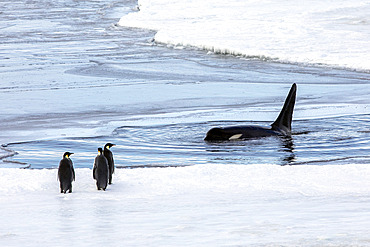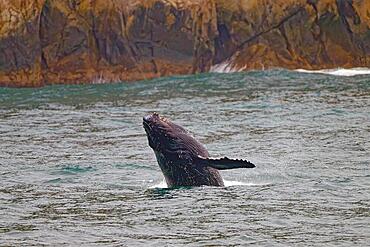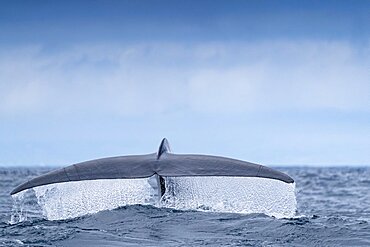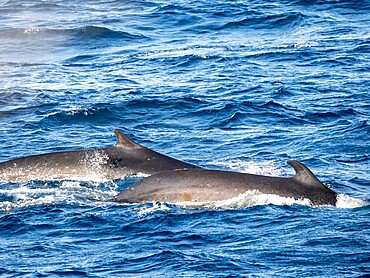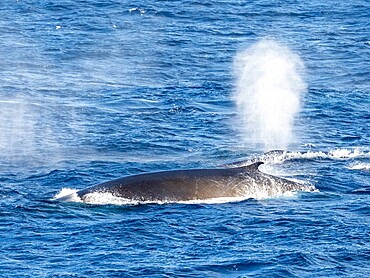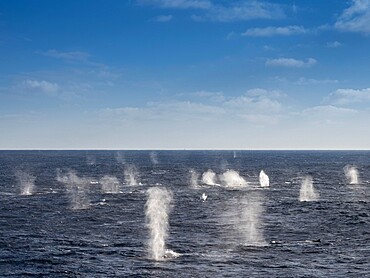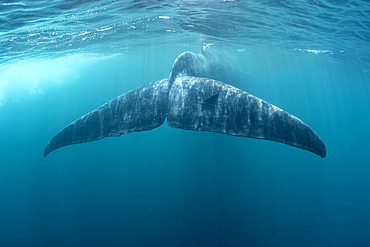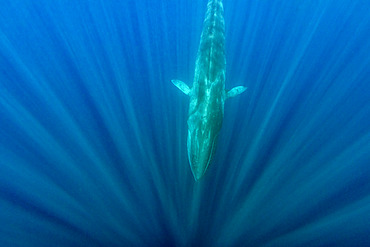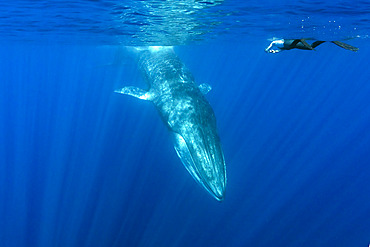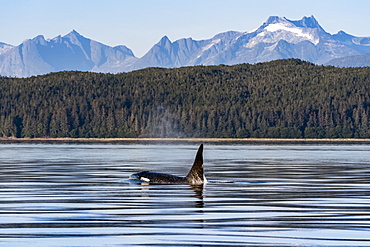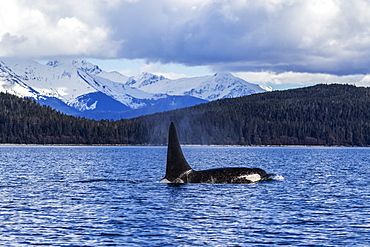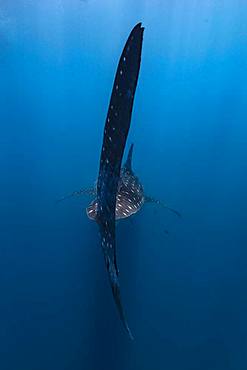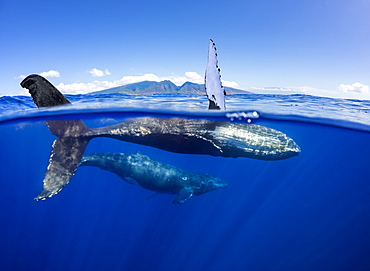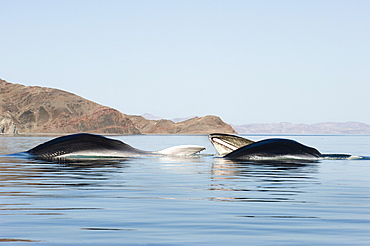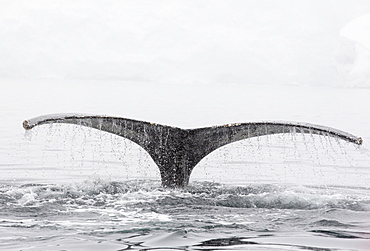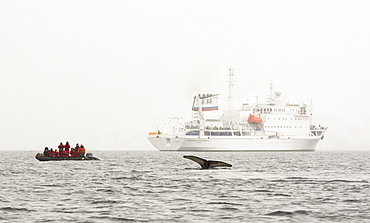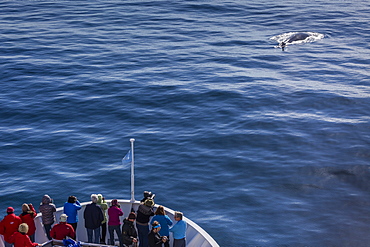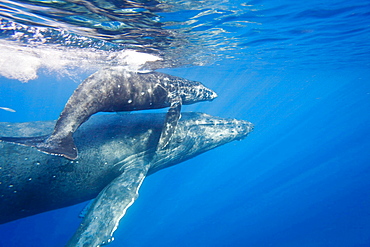Recent searches
Loading...
860-292189 - Killer whale (Orcinus orca) and Emperor penguins (Aptenodytes forsteri) on pack ice in the Ross Sea, McMurdo Sound, Antarctica
832-404487 - Humpback whale (Megaptera novaeangliae) up to the pectoral fin above the water surface, rocky coastline behind, Kenai Fjords National Park, Alaska, USA, North America
860-291096 - Tail of Blue whale diving (Balaenoptera musculus) Reaching a maximum confirmed length of 30 meters and weighing up to 200 tons, it is the largest animal known to have ever existed. Azores, Portugal, Atlantic Ocean.
1112-6890 - A pair of adult fin whales (Balaenoptera physalus) surfacing in Kenai Fjords National Park, Alaska, United States of America, North America
860-290604 - killer whale, Orcinus orca, spy hop, Vestfjord, Ofotfjord, and Tysfjord, Lofoten Islands, Norway, Atlantic Ocean
1112-6410 - Adult fin whale (Balaenoptera physalus), feeding on krill near Coronation Island, South Orkney Islands, Antarctica, Polar Regions
1112-6407 - Adult fin whales (Balaenoptera physalus), feeding on krill near Coronation Island, South Orkney Islands, Antarctica, Polar Regions
1112-6413 - Adult fin whales (Balaenoptera physalus), feeding on krill near Coronation Island, South Orkney Islands, Antarctica, Polar Regions
1112-6408 - Adult fin whales (Balaenoptera physalus), feeding on krill near Coronation Island, South Orkney Islands, Antarctica, Polar Regions
1112-6411 - Adult fin whales (Balaenoptera physalus), feeding on krill near Coronation Island, South Orkney Islands, Antarctica, Polar Regions
1112-6409 - Adult fin whales (Balaenoptera physalus), feeding on krill near Coronation Island, South Orkney Islands, Antarctica, Polar Regions
1112-6412 - Adult fin whale (Balaenoptera physalus), feeding on krill near Coronation Island, South Orkney Islands, Antarctica, Polar Regions
832-394190 - Fluke of a humpback whale and body of a humpback whale, whale, Eyjafjoerour, Akureyri, Northern Iceland, Scandinavia, Iceland, Europe
860-290418 - Fin whale (Balaenoptera physalus) is the largest baleen whale found in the Mediterranean Sea. It is the world?s second largest cetacean, after the blue whale. Pelagos Sanctuary for Mediterranean Marine Mammals, Mediterranean Sea
860-289798 - Adult, female Humpback whale (Megaptera novaeangliae) breaching, Reunion, overseas department and region of the French Republic and an Indian Ocean island in East Africa
860-289980 - Tail of Blue whale (Balaenoptera musculus brevicauda) is the largest animal ever known to have existed. This may be the pygmy sub-species of blue whale, Balaenoptera musculus. Mirissa, Sri Lanka, Indian Ocean Photo taken under permit
860-290420 - Fin whale (Balaenoptera physalus) is the largest baleen whale found in the Mediterranean Sea. It is the world?s second largest cetacean, after the blue whale. Pelagos Sanctuary for Mediterranean Marine Mammals, Mediterranean Sea
860-290419 - Fin whale (Balaenoptera physalus) is the largest baleen whale found in the Mediterranean Sea. It is the world?s second largest cetacean, after the blue whale. Pelagos Sanctuary for Mediterranean Marine Mammals, Mediterranean Sea
860-290421 - Snorkeler and fin whale (Balaenoptera physalus) is the largest baleen whale found in the Mediterranean Sea. It is the world?s second largest cetacean, after the blue whale. Pelagos Sanctuary for Mediterranean Marine Mammals, Mediterranean Sea
1112-5954 - A pair of adult fin whales (Balaenoptera physalus), surfacing off Point Wild, Elephant Island, Antarctica, Polar Regions
1116-49970 - Killer whale (Orcinus orca) surfacing beside the Chilkat Mountains at sunset, Lynn Canal, Inside Passage; Alaska, United States of America
1116-49959 - Killer whale (Orcinus orca) surfacing beside the Coastal range, Inside Passage, Lynn Canal; Alaska, United States of America
1112-5610 - Adult fin whales (Balaenoptera physalus) surfacing in Loreto Bay National Park, Baja California Sur, Mexico, North America
1116-47623 - Humpback whale (Megaptera novaeangliae) pectoral fin, Lahaina, Maui, Hawaii, United States of America
1116-47624 - Humpback whale (Megaptera novaeangliae) breaching, Lahaina, Maui, Hawaii, United States of America
1116-48662 - Humpback whale pectoral fin, Lahaina, Maui, Hawaii, United States of America
1116-47671 - Killer whale (Orcinus orca), also known as Orca, swimming in Inside Passage with the Chilkat Mountains in the background, Alaska, United States of America
1116-47619 - Humpback whale (Megaptera novaeangliae) pectoral fin, Lahaina, Maui, Hawaii, United States of America
1112-4692 - Adult fin whale (Balaenoptera physalus), surfacing near Point Wild, Elephant Island, Antarctica, Polar Regions
1116-47193 - Orca Whales (Orcinus Orca) Surface Near Juneau In Lynn Canal, Inside Passage, With The Coast Range In The Background, Alaska, United States Of America
1116-46828 - A calf imitates its mother swimming upside down. The sperm whale (Physeter macrocephalus) is the largest of all the toothed cetaceans. Males can reach 60 feet in length. Photographed in the Indian Ocean off the coast of Sri Lanka, Sri Lanka
1116-46667 - An Orca Whale, Or Killer Whale, (Orcinus Orca) Surface Near Juneau In Lynn Canal, Inside Passage, Alaska, United States Of America
860-288167 - Omura's whale (Balaenoptera omurai) portrait, Nosy Be, Madagascarlast identified species of fin whale
860-287913 - Tail of sperm whale, (Physeter macrocephalus). Vulnerable (IUCN). The sperm whale is the largest of the toothed whales. Sperm whales are known to dive as deep as 1,000 meters in search of squid to eat. Image has been shot in Dominica, Caribbean Sea, Atlantic Ocean. Photo taken under permit n°RP 16-02/32 FIS-5.
860-287558 - Behind the huge caudal fin of a whale shark (Rhincodon typus), Madagascar
860-287057 - Humpback whale (Megaptera novaeangliae) Calf playing with photographer, Tonga Island, Vava'u, Pacific Ocean
1116-42864 - An Orca Whale (Orcinus Orca), A Male Indicated By The Height Of Its Dorsal Fin, Surfaces In Lynn Canal On A Summer Evening, Inside Passage, Alaska, United States Of America
1116-41506 - A split image of a pair of humpback whales (Megaptera novaeangliae) underwater and above, Maui, Hawaii, United States of America
1116-41507 - A split image of a pair of humpback whales (Megaptera novaeangliae) underwater in front of the West Maui Mountains just south of Lahaina, Maui, Hawaii, United States of America
1116-41392 - A mother and calf pair of humpback whales (Megaptera novaeangliae) at the surface of the water off the island of Maui, Hawaii, United States of America
1116-41393 - Humpback whale (Megaptera novaeangliae) diving through the surface of the water, Hawaii, United States of America
1116-41391 - The island of Lanai is in the background of this breaching Humpback whale (Megaptera novaeangliae), Lanai, Hawaii, United States of America
832-381734 - Fluke of a Sperm Whale (Physeter macrocephalus) while diving, Kaikoura, Canterbury Region, New Zealand, Oceania
1116-39970 - Humpback Whale (Megaptera novaeangliae) just about to break the surface to take a breath, Hawaii, United States of America
1116-39969 - An aerial view of a Humpback Whale (Megaptera novaeangliae) just below the surface, Lanai City, Lanai, Hawaii, United States of America
1116-39972 - Humpback Whale (Megaptera novaeangliae) underwater, Hawaii, United States of America
1116-40052 - Humpback whale (Megaptera novaeangliae) breaching, Lahaina, Maui, Hawaii, United States of America
1116-39973 - An aerial view of a Humpback Whale (Megaptera novaeangliae) at the surface of the water, Lanai City, Lanai, Hawaii, United States of America
1116-39968 - An aerial view of a Humpback Whale (Megaptera novaeangliae) surfacing beside a vessel, Lanai City, Lanai, Hawaii, United States of America
1116-39971 - Humpback Whale (Megaptera novaeangliae) rolls over just below the surface, Hawaii, United States of America
857-94854 - Tail fin of humpback whale (Megaptera novaeangliae) swimming in sea, Wilhelmina Bay, Antarctica
1112-3163 - Adult humpback whale (Megaptera novaeangliae), breaching in the shallow waters of Cabo Pulmo, Baja California Sur, Mexico, North America
917-610 - Fin Whale, Balaenoptera physalus, surfacing, near Pico, Azores, Atlantic Ocean
917-616 - Fin Whale, Balaenoptera physalus, surfacing at speed, blowing, showing jaw line, mouth, blowhole, Pico, Azores, Atlantic Ocean
917-608 - Gervais Beaked Whale, Mesoplodon europaeus, adult surfacing, showing dorsal fin, extremely rare image, Azores, Atlantic Ocean
860-285216 - Humpback whales swimming at the surface, Sea of ??Cortez
860-285220 - Humpback whale tail close to shore, Sea of ??Cortez
860-285218 - Humpback whales pectoral fin at surface, Sea of ??Cortez
860-285264 - Lunge feeding fin whales, Gulf of California
911-10813 - Minke Whales(Balaenoptera acutorostrata) feeding in the Gerlache Strait separating the Palmer Archipelago from the Antarctic Peninsular off Anvers Island. The Antartic Peninsular is one of the fastest warming areas of the planet.
911-10811 - Humpback Whales (Megaptera novaeangliae) feeding on Krill in Wilhelmena Bay, Antarctic Peninsular. The whales migrate here in the summer to feed on the Krill. Krill numbers have declined by over 50%. They feed on algae that grows on the underside of sea ice, As the sea ice melts, both algae and krill decline.
911-10812 - Humpback Whales (Megaptera novaeangliae) feeding on Krill in Wilhelmena Bay, Antarctic Peninsular. With passengers from an expedition crusie in Zodiaks. The whales migrate here in the summer to feed on the Krill. Krill numbers have declined by over 50%. They feed on algae that grows on the underside of sea ice, As the sea ice melts, both algae and krill decline.
911-10810 - Humpback Whales (Megaptera novaeangliae) feeding on Krill in Wilhelmena Bay, Antarctic Peninsular. The whales migrate here in the summer to feed on the Krill. Krill numbers have declined by over 50%. They feed on algae that grows on the underside of sea ice, As the sea ice melts, both algae and krill decline. An expedition cruise ship in the background
911-9958 - Humpback Whales (Megaptera novaeangliae) feeding on Krill in Wilhelmena Bay, Antarctic Peninsular and surfacing wth a metre of a zodiak. The whales migrate here in the summer to feed on the Krill. Krill numbers have declined by over 50%. They feed on algae that grows on the underside of sea ice, As the sea ice melts, both algae and krill decline. This shot has penguins resting on an iceberg in the background.
1112-2614 - A single adult blue whale (Balaenoptera musculus) surfacing in deep water off Funchal, Madeira, Portugal, Atlantic, Europe
1112-2516 - Possible cow and calf fin whale (Balaenoptera physalus) surfacing near Hornsund, Spitsbergen, Svalbard, Arctic, Norway, Scandinavia, Europe
1112-2517 - Adult fin whale (Balaenoptera physalus) surfacing near Hornsund, Spitsbergen, Svalbard, Arctic, Norway, Scandinavia, Europe
1112-2518 - Adult fin whale (Balaenoptera physalus) surfacing near Hornsund, Spitsbergen, Svalbard, Arctic, Norway, Scandinavia, Europe
1112-2585 - Adult fin whale (Balaenoptera physalus) surfacing off the bow of the National Geographic Explorer, Spitsbergen, Svalbard, Arctic, Norway, Scandinavia, Europe
832-374850 - Short-beaked Dolphins (Delphinus delphis) in the Atlantic, off Algarve, Portugal, Europe
1174-1924 - An Orca, a killer whale swimming in the ocean in Antarctica
971-60 - Lunge-feeding fin whale (Balaenoptera physalus) showing distended throat grooves, Northeast Atlantic, off Morocco, North Africa, Africa
832-252359 - Whale fin in front of Space Needle, City Center, night shot, Seattle, U.S state of Washington, USA, North America
1161-7962 - Whale tail fin in the Golfo Nuevo in Patagonia, Argentina, South America
1112-1202 - Adult fin whales (Balaenoptera physalus) surfacing off the west coast of Spitsbergen, Svalbard, Norway, Scandinavia, Europe
1112-1203 - Adult fin whale (Balaenoptera physalus) surfacing off the west coast of Spitsbergen, Svalbard, Norway, Scandinavia, Europe
1112-1199 - Adult fin whale (Balaenoptera physalus) surfacing near Gosbergkilen, Spitsbergen, Svalbard, Norway, Scandinavia, Europe
1112-1201 - Adult fin whale (Balaenoptera physalus) surfacing near Gosbergkilen, Spitsbergen, Svalbard, Norway, Scandinavia, Europe
1112-1200 - Adult fin whale (Balaenoptera physalus) surfacing near Gosbergkilen, Spitsbergen, Svalbard, Norway, Scandinavia, Europe
869-4152 - humpback whale A mother and calf surface off the island of Maui Hawaii
869-4169 - humpback whale Breaching Humpback whale Megaptera novaeangliae Hawaii
869-4154 - humpback whale breaching whale in front of Lahaina Maui Hawaii
869-4155 - humpback whale whale calf leaves it's mother for a close look at the camera Hawaii
869-826 - humpback whale tail fin or fluke of diving whale above sea surface water running off fluke in front of mountains at sunset cetacean cetaceans identification profile fluke margin margins one animal only horizontal format
1112-1049 - Antarctic Minke whale (Balaenoptera bonaerensis), Booth Island, Antarctica, Southern Ocean, Polar Regions
1112-1065 - Type A killer whales (Orcinus orca) travelling and socializing in Gerlache Strait near the Antarctic Peninsula, Southern Ocean, Polar Regions
1112-1050 - Antarctic Minke whale (Balaenoptera bonaerensis), Booth Island, Antarctica, Southern Ocean, Polar Regions
1112-1062 - Type B killer whales (Orcinus orca) travelling and socializing in Lemaire Channel near the Antarctic Peninsula, Southern Ocean, Polar Regions
1112-1066 - Type A killer whales (Orcinus orca) travelling and socializing in Gerlache Strait near the Antarctic Peninsula, Southern Ocean, Polar Regions
1112-1064 - Type A killer whale (Orcinus orca) bull, traveling and socializing in Gerlache Strait near the Antarctic Peninsula, Southern Ocean, Polar Regions
1112-1063 - Type A killer whales (Orcinus orca) travelling and socializing in Gerlache Strait near the Antarctic Peninsula, Southern Ocean, Polar Regions
990-139 - The Indian summer colours the tree line along the coast indicating the oncoming winter. A sign that Minke whales (Balaenoptera acutorostrata) should start their migration south to unknown waters. St. Lawrence estuary, Canada
990-180 - She canÃt be more trusting than that. A curious Minke whale (Balaenoptera acutorostrata) has turned upside down exposing her white belly, navel and genital slits to the photographer. St. Lawrence estuary, Canada
990-170 - The distinctive colouration pattern of a Minke whale (Balaenoptera acutorostrata). Note that the typical white flipper band extends on to the lower side of the pectoral fin. St. Lawrence estuary, Canada (RR)
990-173 - Tall dorsal fin of a Finback whale (Balaenoptera physalus) which is located far back along the dorsal ridge. This prominent feature is often used for identification. St. Lawrence estuary, Canada
990-171 - Tiny water droplets catch the last light of the setting sun as this Finback whale (Balaenoptera physalus) exhales blasting the air compressed in its huge lungs high into the air. St. Lawrence estuary, Canada
990-141 - A beautiful and powerful cloud formation above the surfacing Minke whales (Balaenoptera acutorostrata). St. Lawrence estuary, Canada
990-172 - Finback whale (Balaenoptera physalus) arching its back in order to dive showing its tall dorsal fin and patches of green algae that cover its back. St. Lawrence estuary, Canada
990-174 - The white tip of a Finback whaleÌs (Balaenoptera physalus) snout showing a distinctive characteristic of this species; the lower right jaw is white in colour whereas the left side is dark. Gasp», Canada
